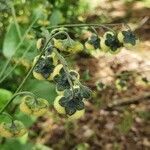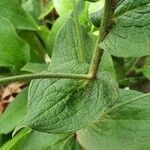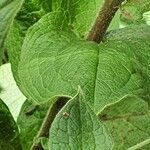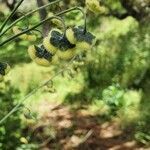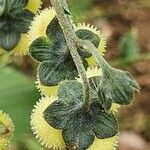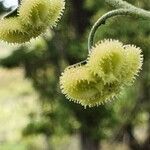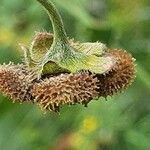Inferior leaves petiolate, the superior ones sessile; petiole up to 13(42) cm. long, with sheathing base; lamina of the inferior leaves 12–20 x 7–12 cm., becoming progressively smaller to the apex, ovate or less often elliptic, shortly and sparsely hispid on both surfaces, acute at apex and sometimes apiculate, obtuse to subcordate at base and suddenly decurrent on the petiole.
Corolla usually blue, often with reddish throat, sometimes the whole whitish; tube 1.4–1.6 mm. long, slightly infundibuliform; limb 4–6 mm. in diam.; lobes 1.4–2.4 x 1.0–2.6 mm., very widely ovate to depressed-ovate, obtuse, much veined.
Fruits 10–12 mm. in diam., on usually reflexed pedicels up to 17 mm. long; nutlets 5–6 mm. in diam., free from the style, with the outer surface convex and ± uniformly covered with 0.5–0.6 mm. long glochids.
Stamens inserted at 0.6–1.0 mm. from the base of the corolla tube; anthers 0.6–0.7 mm. long, elliptic-oblong, obtuse, subcordate at base; filaments 0.3–0.5 mm. long.
Calyx appressed-pubescent outside, glabrous inside; lobes 1.0–2.5 x 1.2–1.7 mm., elliptic to very widely ovate, subacute to rounded at apex.
A rhizomatous perennial herb 0.8–1.8(3.5) m. high, much branched, with shortly and retrorsely hispid often reddish annual stems.
Inflorescence of short racemes arranged in terminal bracteate panicles; bracts ovate to lanceolate, acute.
Ovary c. 1 mm. in diam.; style overlapping the ovary by 0.3–0.6 mm.; stigma globulose, terminal.
Flowers with pedicels 2–4 mm. long.
